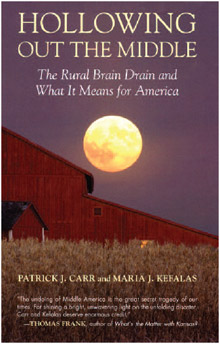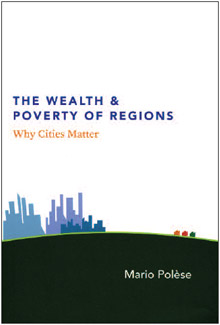Hollowing Out the Middle
The Rural Brain Drain and What It Means for America
By Patrick J. Carr and Maria J. Kefalas
Beacon Press
239 pages
The Wealth and Poverty of Regions
Why Cities Matter
By Mario Polèse
University of Chicago Press
254 pages
What can people be paying Manhattan or downtown Chicago rents for, if not for being near other people?
—Robert E. Lucas
My mother and father grew up on North Dakota farms in first-generation and second-generation immigrant families, respectively. Between their families, there were 18 children, 14 of whom stayed in the state to seek their fortunes and raise their own families. I grew up in one of those families in Bismarck, N.D., along with my eight brothers and sisters, only one of whom now lives in the state. The rest of us are scattered from coast to coast, with one overseas. So, from one generation to the next, the stay-at-home rate went from 78 percent in my parents’ families to 11 percent in the family they created.
Multiply that one little anecdote by many thousands, and you have the demographic story of the Great Plains, as well as other rural areas in the United States, as people have moved from the farm to nearby cities and to points across the country and around the world, all within a couple of generations. If you were one of the authors of Hollowing Out the Middle, you would view this as a big problem for those rural areas and a call for action. But if you were the author of The Wealth and Poverty of Regions, you would view this as so much economic destiny, an unsurprising trend that has occurred throughout the world as technological efficiencies have shifted labor from the land to the city.
That these two books would have such distinct reactions to this demographic phenomenon is suggested by the backgrounds of the authors. Hollowing Out the Middle is written by two sociologists who traveled to a small (unnamed) town in Iowa to survey its citizens and to come to a better understanding of why so many young people choose to leave. During their stay, the authors turned their focus from “is” statements (what is happening) to “ought” statements (what ought to be done). In other words, they saw some facts and wanted to change them. The Wealth and Poverty of Regions is written by an economic geographer interested in why differences in wealth exist among different communities and regions within nations. In his case, he saw some facts and wanted to explain them.
These issues are important, not only for rural areas that are struggling with what to do, if anything, about dwindling populations, but also for successful small cities and large metro areas that want to keep their competitive edge. A lot of money is spent every year by government offices at all levels to revive this region or that town or another city. Some succeed, many fail and most keep trying.
Many achieve, few return

The value of Hollowing Out the Middle is in its original premise, which was to survey “the experiences of young adults from nonmetropolitan America” on choices those young people make about their future. Carr and Kefalas group these young adults into the following categories: Achievers, Stayers, Seekers and Returners (broken down as High-Flyers and Boomerangs). For anyone interested in the stories behind the demographic ebb and flow of the rural Midwest, these chapters add insight to the data. For example, the following stories are told:
- Achievers: A young girl likes her small-town Iowa life and would prefer to stay, but she knows she has to leave to achieve any sort of professional potential. Indeed, her parents encourage her to leave. She attends Stanford and completes a graduate degree in statistics.
- Stayers: Young women decide to stay and marry and begin families. One testifies: “I thought that’s just what I had to do. Not that I had to do it, I just—that’s what I wanted to do. I was at a point in my life where I was like, ‘Let’s get this going.’”
- Seekers: These young people are trying to get out, and many do not have the educational aspirations of their classmates. The military is a primary option. “The fact that he ‘didn’t have the best grades in the world’ and that heading straight to college would not be in the cards led him to view the Navy as ‘the best thing,’ if only because it ‘saved’ him ‘from getting trapped.’”
- Returners: One young couple, high school sweethearts, return after earning professional degrees and finding opportunities to put those degrees to work. These are Returners of the High-Flyer variety. “‘Probably the biggest motivating factor’ in returning to the Iowa countryside, Liz said, ‘was my family. I want to be close to my extended family. … I chose to stay here because I wanted to raise my children [here]. I enjoy Iowa.’”
If only the authors had stopped there, they would have produced a useful text—although perhaps a lengthy paper instead of a book—that contributes to our understanding of the changing nature of the rural Midwest. Instead, they take the perilous plunge from “is” to “ought.” So why should we care about the depopulation of the Midwest? “We should care because the Heartland is the place where our food comes from, it is the place that helps elect our presidents … and it is the place that sends more than its fair share of young men and women to fight for this country.”
On the first point, of course we need to care about where our food comes from, whether from land, water or air, inasmuch as we want to preserve and protect the natural endowments that will allow the necessary production of that food. But whether that food is produced on land dotted with towns of 1,000 people or 500 people is of little concern, as we know that there will always be enough labor there to produce what consumers want. Indeed, as Polèse notes in his book, this reduction in agricultural employment reflects increased productivity that has improved the standard of living of rural residents and their city cousins. One way we all benefit from this economic phenomenon is less expensive food, and that’s a pretty good outcome.
As to the second point, I am sure that political scientists, political activists and politicians themselves will adequately negotiate presidential primary schedules to better balance the influence of certain states over others. Recent election cycles have seen many states move up their primary dates so as to increase their influence and, thus, the influence of a greater number of American voters. The U.S. political system is changeable; there hardly seems a need to keep rural Iowa populated just because the state has a key primary every four years.
Finally, that a “fair share” of rural youth end up in the military is perhaps owing to the story told above: It’s a way out of a small town when there are limited options; or perhaps small-town youth are more driven to serve their country through military service because of tradition, patriotism or some other cultural factor; or perhaps it’s a combination of economic and cultural factors, as well as others. Regardless, these recruits will come from somewhere—quotas will be met—and it doesn’t seem like a good use of limited resources to keep rural areas thriving to provide a farm system (no pun intended) for the military.
Besides the anecdotal stories in Hollowing, the best reason to read this book is one that the authors probably did not intend: It chronicles many of the mostly failed attempts over the years of rural states and towns to reverse the flow of young people and create opportunities for job growth. Many of these schemes involve subsidies of money, taxes and land, and are packaged as slick marketing campaigns to woo both businesses and residents. The authors are encouraged by these efforts, even those that failed, because there are lessons to be learned in the attempt. And they think even more creativity is needed.
Anybody from a rural state involved in programs to retain young people in rural areas, or who otherwise cares about them, would benefit from these stories, if only to forearm their labors. The authors have a zealous belief in these attempts, a faith quite possibly more fervent than that held by many of the state and local officials who work toward these goals and who have been chastened by economic and demographic reality over the years. As the authors note about themselves: “[A]s converts are often identifiable by the strength of their zeal, our immersion in this issue fueled a great desire to place the hollowing-out phenomenon on the crowded national to-do list.” But with limited resources and a host of public policy problems to consider, should officials really put this issue at the top of their list, or include it on the list at all? Carr and Kefalas do not make a convincing case, but they do tell some useful cautionary tales.
Size, location and cost rule the day

Carr and Kefalas have one map in their book—it shows net out-migration in U.S. counties from 1980 to 2000, and it shows the movement out of America’s interior counties. Rather than a straight descriptive label, Carr and Kefalas headline this map “Decimation of America’s Heartland.” The word decimation suggests that something awful has been done to this region, and the use of the word Heartland suggests that this is a special place, worthy of sympathy and concern.
Polèse begins his book with a series of maps from around the world depicting income and GDP per person and population change, among other data points. These maps tell stories, and a close reading reveals much of what Polèse will later describe in his analysis: People have been moving to cities for decades, and that’s where employment and wealth have been growing. Included in this series is a map showing population growth in the United States and Canada. Around the middle of this map, from central Canada to much of western Texas, Polèse draws a line and labels it the “Empty Quarter.” His caption matter-of-factly states, “Large swaths of North America are losing population,” and his other maps, including the one showing employment density, help explain this picture of population decline.
One of the values of Polèse’s book, even if one is only interested in the growth experience of U.S. regions, is that his description of other areas around the world reminds readers that the historical demographic phenomenon of population gravitation toward cities is not special to this or that region. It simply is. Additionally, Polèse’s focus on economic geography encourages readers to think beyond often arbitrary state lines and consider economies as reflective of geographic space.
Polèse packs a lot into this slim book, and much can be gained from his chapter describing the merits of size and location, in which he introduces his four golden rules of economic growth for regions within nations:
- Size matters: Dynamic industries are drawn to large cities and places within easy reach. The corollary is that proximity to size also matters.
- Location matters: And it’s largely a story about trade corridors and proximity to trading partners.
- Costs matter: If a city isn’t large enough and/or blessed with location advantages, it had better have a labor cost advantage or resource endowment. However, a resource endowment is not necessarily better for everyone, as suggested by certain oil-rich countries where just a few benefit.
- Exceptions abound: For a variety of reasons, politics or technological shocks among them, certain places are freed from the previous three rules and can thrive. But it’s not easy.
These rules are golden for a reason—they’re well tested by time and mostly intuitive. Still, full consideration of their deeper implications will yield insight even for those well versed in regional economic development thinking. Polèse takes the time to describe and explain why cities grow, why proximity matters and how some small cities can retain advantages. The seven key principles (or pillars of agglomeration, as Polèse terms them) are scale economies in production and transportation, falling transportation costs, the need for proximity, the advantages of diversity, the desire to be close to the center of markets and—on a more micro note—the need for people to be near the “buzz and bright lights.”
This last principle recalls the insight of the economist Robert Lucas quoted at the beginning of this review. People move to Manhattan and Chicago and London and, well, Minneapolis, to be near other people. Carr and Kefalas may disagree, arguing that people move to those places because they have no other choice—that they would rather stay down on the farm or in little villages, but they can’t because those places offer no opportunity. Polèse thinks there is more to it:
Ambition, dreams, and the need for recognition are powerful forces driving human behavior. … The main impetus behind agglomeration undoubtedly remains economic, but agglomeration also fulfills a social need. Human beings are nothing if not social animals. The life of a hermit may appeal to some, but the vast majority of humanity seeks company. We seek the approval of others, to see others and to be seen.
And where are the best places to “seek the approval of others, to see others and to be seen”? Likely, it’s the places with the brightest lights and most exciting buzz. This especially applies to young people, Polèse notes, who have the most ambition and so will have a corresponding positive effect on the cities where they land. Eventually, also, many of those young people settle down in those cities and start families, and the cycle continues.
But is this a virtuous cycle? Is America losing something because people are choosing to move from rural areas to metropolitan areas? For an economic geographer like Polèse, this is practically a meaningless question. People are making choices to better their lives, and what could possibly be wrong with that?
As long as people need to meet, the places where they can most profitably do so will continue to command a premium. As the opportunity of time increases with higher incomes, so will the true cost of travel.
A world in which place no longer matters is a fantasy. Were that unlikely event ever to occur, we would recognize the signs immediately. Place will have ceased to matter the day a square foot of land in, say, downtown Bismarck, North Dakota, costs the same as a square foot of land in Midtown Manhattan. I leave it to the reader to evaluate the likelihood of that ever happening.
Ouch. Of all the downtowns in all the world, he had to pick on my hometown. But Polèse’s point is well made. Those land prices are market signals, and they also signal the likelihood that Bismarck incomes will be correspondingly lower. Polèse is careful in making this point: Special cases abound, but on average, smaller places like Bismarck are explained by the rules of size and location. And, ahem, Bismarck—with an unemployment rate of under 3 percent this fall—is something of a special case, as it lies in the heart of a state benefiting from a boom in oil and agricultural products. Still, no matter how high the price of oil or wheat, Bismarck residents will likely never experience downtown rents or income levels like their cousins in Manhattan.
So, are the rules of size and location destiny? Is there nothing that smaller towns and cities (and many of them are much smaller than Bismarck) can do? While size and location “are not easily amenable to public policy,” and while “public policy cannot undo the past,” and while natural endowments cannot be unendowed, there might still be opportunities for certain cities or regions, according to Polèse. “There are good economic reasons why different-sized cities emerge at different locations and why they will continue to exist,” he writes.
However, place will always matter, Polèse writes, even at a time when information is flattening the world; indeed, place will matter even more. “The cost of moving information is already close to zero. But, at the same time, the need to interact with others will grow. This is one of the ironies of recent times, which makes the study of regional economies so fascinating and ensures that geography will not wither away.” It’s also a reason why this book—which covers much more than this review can address—makes for an informative read.
Closing note: For those readers either involved in the business of economic development at the city level or otherwise interested in the subject, the Federal Reserve Bank of Boston published “Lessons from Resurgent Cities” in its 2009 Annual Report. Boston Fed researchers identified 10 such cities that rebounded from a heavy dependence on a particular manufacturing industry and determined common attributes of those cities. While they may offer lessons, the researchers don’t offer false hope: “No research study is capable of laying out the agenda for a struggling city.” Instead the report hopes to describe “reasonable aspirations” and to “add to the available information concerning the economic development approaches tried by their peers.”





